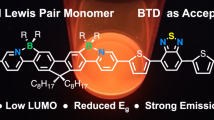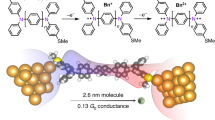Abstract
Electron transfer from electron-donor to electron-acceptor molecules via a molecular ‘bridge’ is a feature of many biological andchemical systems. The electronic structure of the bridge component in donor–bridge–acceptor (DBA) systems is known to play a critical role in determining the ease of electron transfer1,2. In most DBA systems, the rate at which electron transfer occurs scales exponentially with the donor–acceptor distance — effectively the length of the bridge molecule. But theory predicts that regimes exist wherein the distance dependence may be very weak, the bridge molecules essentially acting as incoherent molecular wires3,4,5,6. Here we show how these regimes can be accessed by molecular design. We have synthesized a series of structurally well-defined DBA molecules that incorporate tetracene as the donor and pyromellitimide as the acceptor, linked by p -phenylenevinylene oligomers of various lengths. Photoinduced electron transfer in this series exhibits very weak distance dependence for donor–acceptor separations as large as 40 Å, with rate constants of the order of 1011 s−1. These findings demonstrate the importance of energy matching between the donor and bridge components for achieving molecular-wire behaviour.
This is a preview of subscription content, access via your institution
Access options
Subscribe to this journal
Receive 51 print issues and online access
$199.00 per year
only $3.90 per issue
Buy this article
- Purchase on Springer Link
- Instant access to full article PDF
Prices may be subject to local taxes which are calculated during checkout




Similar content being viewed by others
References
Barbara, P. F., Meyer, T. J. & Ratner, M. A. Contemporary issues in electron transfer research. J. Phys. Chem. 100, 13148–13168 (1996).
Wasielewski, M. R. Photoinduced electron transfer in supramolecular systems for artificial photosynthesis. Chem. Rev. 92, 435–461 (1992).
Ratner, M. A. & Jortner, J. in Molecular Electronics(eds Jortner, J. & Ratner, M.) 5–72 (Blackwell, Oxford, (1997)).
Davis, W. B., Wasielewski, M. R., Ratner, M. A., Mujica, V. & Nitzan, A. Electron transfer rates in bridged molecular systems: A phenomenological approach to relaxation. J. Phys. Chem. A 101, 6158–6164 (1997).
Okada, A., Chernyak, V. & Mukamel, S. Solvent reorganization in long-range electron transfer: density matrix approach. J. Phys. Chem. A 102, 1241–1251 (1998).
Pollard, W. T., Felts, A. K. & Friesner, R. A. The Redfield equation in condensed-phase quantum dynamics. Adv. Chem. Phys. 93, 77–134 (1996).
Winkler, J. R. & Gray, H. B. Electron transfer in ruthenium-modified proteins. Chem. Rev. 92, 369–379 (1992).
Moser, C. C., Keske, J. M., Warncke, K., Farid, R. S. & Dutton, P. L. Nature of biological electron transfer. Nature 355, 796–802 (1992).
Lewis, F. D.et al. Distance-dependent electron transfer in DNA hairpins. Science 277, 673–676 (1997).
Holmlin, R. E., Dandliker, P. J. & Barton, J. K. Charge transfer through the DNA base stack. Angew. Chem. Int. Edn. Engl. 36, 2715–2730 (1998).
Johnson, M. D., Miller, J. R., Green, N. S. & Closs, G. L. Distance dependence of intramolecular hole and electron transfer in organic radical ions. J. Phys. Chem. 93, 1173–1176 (1989).
Oevering, H.et al. Long-range photoinduced through-bond electron transfer and radiative recombination via rigid nonconjugated bridges: distance and solvent dependence. J. Am. Chem. Soc. 109, 3258–3269 (1987).
Helms, A., Heiler, D. & McLendon, G. Electron transfer in bis-porphyrin donor-acceptor compounds with polyphenylene spacers shows a weak distance dependence. J. Am. Chem. Soc. 114, 6227–6238 (1992).
Ribou, A.-C.et al. Intervalence electron transfer in pentaammineruthenium complexes of dipyridylpolyenes, dipyridylthiophene, and dipyridylfuran. Inorg. Chem. 33, 1325–1329 (1994).
Arrhenius, T. S., Blanchard-Desce, M., Dvolaitzky, M., Lehn, J. M. & Malthete, J. Molecular devices: caroviologens as an approach to molecular wires — synthesis and incorporation into vesicle membranes. Proc. Natl Acad. Sci. USA 83, 5355–5359 (1986).
Wasielewski, M. R.et al. in Photochemical Energy Conversion(ed. Norris, J. R.) 135–147 (Elsevier, New York, (1989)).
Effenberger, F. & Wolf, H. C. Terminally substituted conjugated polyenes: synthesis and energy transfer properties. New J. Chem. 15, 117–123 (1991).
Tolbert, L. M. Solitons in a box: the organic chemistry of electrically conducting polyenes. Acc. Chem. Res. 25, 561–568 (1992).
Tour, J. M. Conjugated macromolecules of precise length and constitution. Organic synthesis for the construction of nanoarchitectures. Chem. Rev. 96, 537–553 (1996).
Grosshenny, V., Harriman, A. & Ziessel, R. Towards the development of molecular wires: electron localization, exchange, and transfer in alkyne-bridged multinuclear complexes. Angew. Chem. Int. Edn. Engl. 34, 2705–2708 (1996).
Sachs, S. B.et al. Rates of interfacial electron transfer through π-conjugated spacers. J. Am. Chem. Soc. 119, 10563–10564 (1997).
Burgdorff, C., Ehrhardt, S. & Loehmannsroeben, H. G. Photophysical properties of tetracene derivatives in solution. 2. Halogenated tetracene derivatives. J. Phys. Chem. 95, 4246–4249 (1991).
Greenfield, S. R., Svec, W. A., Gosztola, D. & Wasielewski, M. R. Multistep photochemical charge separation in rod-like molecules based on aromatic imides and diimides. J. Am. Chem. Soc. 118, 6767–6777 (1996).
Viehbeck, A., Goldberg, M. J. & Kovac, C. A. Electrochemical properties of polyimides and related imide compounds. J. Electrochem. Soc. 137, 1460–1466 (1990).
Perkampus, H.-H. UV-VIS Atlas of Organic Compounds(VCH, Weinheim, (1992)).
Marcus, R. A. On the theory of oxidation-reduction reactions involving electron transfer. I. J. Chem. Phys. 24, 966–978 (1956).
Mujica, V., Kemp, M., Roitberg, A. & Ratner, M. Current-voltage characteristics of molecular wires: Eigenvalue staircase, Coulomb blockade, and rectification. J. Chem. Phys. 104, 7296–7305 (1996).
Joachim. C. & Vinuesa, J. F. Length dependence of the electronic transparence (conductance) of a molecular wire. Europhys. Lett. 33, 635–640 (1996).
Samanta, M. P., Tian, W., Datta, S., Henderson, J. I. & Kubiak, C. P. Electronic conduction through organic molecules. Phys. Rev. B: Condens. Matter 53, R7626–R7629 (1996).
Burn, P. L.et al. Chemical tuning of the electronic properties of poly(p-phenylenevinylene)-based copolymers. J. Am. Chem. Soc. 115, 10117–10124 (1993).
Hoofman, R. J. O. M., De Haas, M. P., Siebbeles, L. D. A. & Warman, J. M. Highly mobile electrons and holes on isolated chains of the semiconducting polymer poly(phenylene vinylene). Nature 392, 54–56 (1998).
Acknowledgements
This work was supported by the Division of Chemical Sciences, Office of Basic Energy Sciences, Department of Energy (M.R.W.), the Chemistry Division of the NSF and ONR (M.A.R.), and the Link Energy Foundation (W.B.D.).
Author information
Authors and Affiliations
Corresponding author
Rights and permissions
About this article
Cite this article
Davis, W., Svec, W., Ratner, M. et al. Molecular-wire behaviour in p -phenylenevinylene oligomers. Nature 396, 60–63 (1998). https://doi.org/10.1038/23912
Received:
Accepted:
Issue Date:
DOI: https://doi.org/10.1038/23912
This article is cited by
-
Quantum interference effects elucidate triplet-pair formation dynamics in intramolecular singlet-fission molecules
Nature Chemistry (2023)
-
Highly conducting single-molecule topological insulators based on mono- and di-radical cations
Nature Chemistry (2022)
-
Functionalized oligoynes: comparison of theoretical parameters with experimental single molecule conductance
Structural Chemistry (2021)
-
Nanoscale membranes that chemically isolate and electronically wire up the abiotic/biotic interface
Nature Communications (2018)
-
Spun films of perylene diimide derivative for the detection of organic vapors with host–guest principle
Journal of Inclusion Phenomena and Macrocyclic Chemistry (2018)
Comments
By submitting a comment you agree to abide by our Terms and Community Guidelines. If you find something abusive or that does not comply with our terms or guidelines please flag it as inappropriate.



